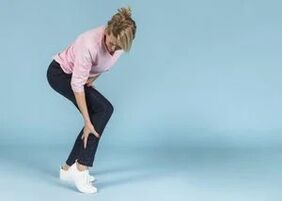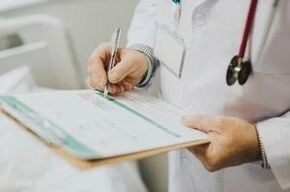Angiosurgeons argue that varicose veins are a pathological process, resulting in the vein wall changing with a subsequent lack of valve.
Cause
The true cause of varicose veins is unknown.Based on epidemiological studies, it is found that genetic tendencies affect the pathological process.

The predisposing factor is also known, from which varicose veins can appear:
- violations of hormone background (menopause, estrogen intake);
- overweight;
- pregnancy;
- long static load;
- wearing tight linen;
- constipation;
- Surgical intervention (arteriovenous bypass);
- Developmental defects or obstacles in the veins.
What does it look like?
Because varicose veins are a modification of veins, pathology is not only listed in vascular disease, but also to cosmetic problems:
- The first patient saw the occurrence of the vein on the leg or the appearance of the mesh vein.
- Then, the veins became convincing, raising the skin.
- In the distance, varicose nodes are clearly visible, representing confusion and expansion of the veins.
Violation of tissue trofism leads to changes in skin pigmentation.
Level (degree)
Some stages, or degrees, varicose veins are distinguished.With varicose veins in the first stage of the patient, the diagnosed heavy leg syndrome is diagnosed.Often the patient complains of cramps in the calf and swollen muscles, which disappear after rest.
With the 2nd degree varicose veins, persistent edema occurs, affected skin pigmentation, stagnant dermatitis.In the case of advanced, trophic ulcers appear in the 3rd disease.
Prevention value
Knowing the factors of predisposition of the disease, attention should be paid to the prevention of varicose veins:
- wearing comfortable shoes and pants;
- Reduction of labor related to static load and prolonged position on the feet;
- Physical Education Classes;
- Vitamin acceptance: C, E, PP;
- Power correction.
If there is no way to change the work that causes the disease, it is recommended to unload gymnastics during the day and drainage in the evening.Wearing elastic bandages and contrast baths will help prevent the disease.
Mark
Symptoms of varicose veins are varied.The clinical picture depends on the disease and localization of the varicose process.
Varicosis of the leg
The initial sign of varicose veins is:
- severity in the feet;
- pressure on the feet;
- fatigue while walking;
- Pastiness in the ankle joint (usually in the evening);
- seizures;
- Pain in the enlarged vein journey.
In women, symptoms are increasing before menstruation.After resting, unpleasant sensations in the feet disappear.
Lymph deficiency in varicose veins leads to the development of cellulite, dermatosclerosis, trophic ulcer, and erysipelas.With severe violations of the venous outflow, the patient complains of itching -skin and dry skin in the affected vein.
Gradually, at the place of infringement of tissue trophism, the skin is thinner and atropic.Hyper- or hypopigmentation develops.With the development of pathological processes, cyanotic spots and trophic ulcers appear.

In a clear process, the patient has a complaint about:
- increased fatigue;
- heart rate;
- breathing difficulties.
These signs are associated with increased load on the heart muscle related to blood deposits in the vein.
Reticular varicose veins from lower lower leg
Special manifestations of varicose veins are reticular varicose veins.Clinical manifestations of pathology:
- increase local temperature in the ankle joint;
- fatigue and weight of feet;
- Dense subcutaneous tissue.
Varicose veins of the esophagus
With the development of varicose veins, convictions and blood vessel bags appear.The main cause of the development of the disease is portal hypertension.
The disease is indicated by the following signs:
- inflammation of the esophagus;
- burning, belching;
- anemia;
- Difficulty in swallowing food.
Complications of dangerous pathology are large bleeding -the veins.Patients have vomiting with blood, hypotension, tachycardia, affected consciousness.
Uterine varicosis
The form of internal varicose veins includes the uterine varicose veins.The main cause of vein change:
- physical activity;
- chronic constipation;
- pregnancy;
- taking hormone contraceptives;
- developmental abnormalities;
- Abortion.
Women with uterine varicose veins complain of pain in the lower abdomen, violation of the menstrual cycle.The disease can cause infertility.
Labia varicose veins
This type of varicose vein in pregnant women can develop from the second month of pregnancy.The disease develops if there is pelvic thrombosis or there is congenital angiodisplasia.
What varicose veins are like:
- expanded vulva veins;
- Brush on the skin due to itching;
- swelling.
The disease is accompanied by a disorder, rupture in the perineum.The danger is the development of acute thrombophlebitis, a broken vessel.
A small pelvic varicose vein
The first signs of varicose veins draw pain in the lower abdomen.There are several options for overcoming the form of the disease:
- varicose and vulva veins;
- Pelvic vein plethora.
Pathological clinical manifestations are observed in 30% of women during pregnancy.The disease is a female pathology alone.
Venous plethora is indicated by the following signs:
- severity and pain;
- pain during sex;
- Dysmenorrhea;
- Urinary tract.
Varicocele
Varicosis of the seed cord in men is called varicocele.The disease leads to a violation of the venous outflow of the penis.Patients complain of pain in the scrotum, erectile dysfunction.When examining the penis, expanded surface veins, the asymmetry of the scrotum can be seen.Reasons -The development of the disease includes:
- physical activity;
- congenital deficiency of connective tissue;
- Tumors in the retroperitoneal or pelvis chamber.
With the development of pathology, spermatogenesis is disrupted, leading to infertility.The disease can be complicated by bleeding from affected vessels.
Varicose dermatitis
In addition to clinical symptoms of progressive varicose veins, the complications should be noted - stagnant dermatitis.In patients, the skin on the affected veins begins to become thinner and itchy.In places of inflammation, spots -dark or light and light spots appear.
The localization of venous dermatitis is the lower leg and ankle joint. With a brush, a pathological process occurs for healthy tissue.If the problem is ignored, inflammation enters the varicose eczema.
Varicose eczema
Inflammation is stubborn with the period of forgiveness and relapse.Skin lesions are treated severely even after humans.Due to the infringement of the micro -circulation, the blood fluid is absorbed through the affected vessel wall.In the area above the varicose veins, the swollen and crying areas appear.
Bubbles filled with serous or serous-blade content occur on the feet.With a brush, the infection goes into the wound.Combining, small bubbles form papules.After opening the vesicles, the crust appears.The healing site is dimmed and covered on a scale.During the severity period, the vesicles occur again.Pathological progress leads to the formation of trophic ulcers.
Pain as a sign of disease

Often patients complain of pain for varicose veins, which are enhanced by the affected vessel palpation.In the early stages, the sign was shown slightly.One feels weak and attracts pain at the end of the day.In the morning, after the break, the symptoms disappear.In the final stage, pain syndrome occurs at night.
The combination of pain and seizures at night or after standing on the feet is considered a classical manifestation of varicose veins.
Localization of pain features for varicose veins:
- overhead region;
- Trophilical ulcer zone;
- Calf muscles.
If the increase in the amount of temperature combines, this may indicate the onset of the inflammatory process in Vienna - thrombophlebitis.
A vascular star
Vascular stars are called telangiocasia.Pathology is characterized by the development of small subcutaneous vessels.On the skin shows itself in the clean form of a purple or red vessel.The cause of telangiectasias is not only a lack of veins, but also:
- Connective tissue disease;
- the pathology of the hepatobiliary system;
- use of hormone drugs;
- Endocrine disease.
The vascular mesh shows itself on the feet, face or back.Telegioectasia is not a separate disease, but acts as a symptom, which represents more cosmetic defects.
Face
In the face, the appearance of a capillary mesh is called rosacea.It seems to violate blood rheological properties, with arterial hypertension or digestive system disease, the negative effects of low temperature or when drinking alcohol.
In women, the main cause of telangiectasia is hormone restructuring.The gold standard to eliminate defects is a laser freezing.
At the foot
In the feet, vascular mesh appears as a result of venous stagnation.Net violet often accompanies varicose veins.As telangiectasia disease develops, it increases.Even after removal of the veins, the capillary mesh remains.Its removal methods are scleroderma, radio frequency ablation, endovasal laser freezing.
How to get rid of?
Before eliminating varicose veins, they are carried out by comprehensive diagnostics.The patient shows the blood and urine examination laboratory method, the detection of reflux for subcutaneous veins, functional samples.Instrumental techniques, they are assigned:
- duplex ultrasound or triplex scanning;
- X -ray phlebography contract;
- magnetic resonance phlebography;
- Multispiral computer angiography with contrast.
After determining the level of varicose veins, the issue uses treatment methods - surgical or conservative therapy.
Who treats?
If the first symptom occurs, you should contact the clinic to phlebology or angiosurgeon. At the district medical facility, the surgeon is involved in the disease.It should be noted that the experience and qualifications of those who treat varicose veins play an important role in eliminating the problem.Therefore, it is best to contact a specific center.
What treatment is needed?
With damage to the lower foot vessels, the following main methods are used:
- surgery;
- sclerosing therapy;
- Conservative treatment.

In advanced cases, the method is combined.In chronic vein deficiency with damage to the blood vessel valve and signs of thrombophlebitis, the removal of the vein (phlebectomy) is indicated.Methods of surgical intervention with minimal properties of intrusion include:
- Vein heat ablation: radio frequency, laser, microwave, steam;
- Nonermal ablation: chemicals with sclerosurizing and mechanical medicines.
To reduce the symptoms of the disease, systemic therapy is prescribed by the drug.The patient is prescribed:
- antibiotics in the process of inflammation and tropical ulcers;
- antiseptic;
- phleboprotectors;
- stimulants of tissue damages;
- anticoagulants;
- Topical steroids with tropical ulcers;
- Local use of heparin containing drugs.
The condition for the removal of effective varicose veins is compression therapy using elastic, golf, tight.The most popular method of wrapping is zinc -watin bandage for trophic disruption.
What helps better?
Preparation and compression bandage (knitwear) are only prescribed by the doctor, taking into account the level of the disease, complications, the pathology included and the patient's age.Therefore, what helps with varicose veins better, phlebologists should tell.
It should be noted that treatment only with medications will not eliminate the pathology, as well as wear compression knitwear.
Varicose veins in most cases are eliminated only in combination with other therapy methods.
How do I get rid of itching?
To get rid of itching with varicose veins, you need to know how to remove it.Doctors prescribe moisturizing therapeutic ointment (you can use children's creams).With severe itching and skin peeling, hormone medications are prescribed.
They use compression with herbal decoctions with anti -inflammatory effects (chamomile, calendula, wise, series, hop cones).
What's dangerous?
As a result of varicose veins include phlebitis, trophic ulcer, thrombophlebitis, menstrual violation, erectile dysfunction, infertility.The formation of thrombus and bleeding from affected vessels is a dangerous varicose vein.
The lower blood cloth from the lower leg in the second fall into a small circulation of blood circulation, causing pulmonary artery thromboembolism.
With bleeding without emergency medical treatment, one loses a lot of blood.All of these complications lead to defects or deaths without adequate treatment.
Conclusion
Varicosis refers to common pathology.It develops in people with descent tendencies with excessive static and dynamic loads, as well as in the absence of prolonged.
The disease leads to serious complications, so if the first signs occur, it is necessary to contact a phlebologist.
You can get rid of the problem with just an integrated approach.
Patients show surgical methods of treatment, medicine, wear compression knitwear and lifestyle correction.
